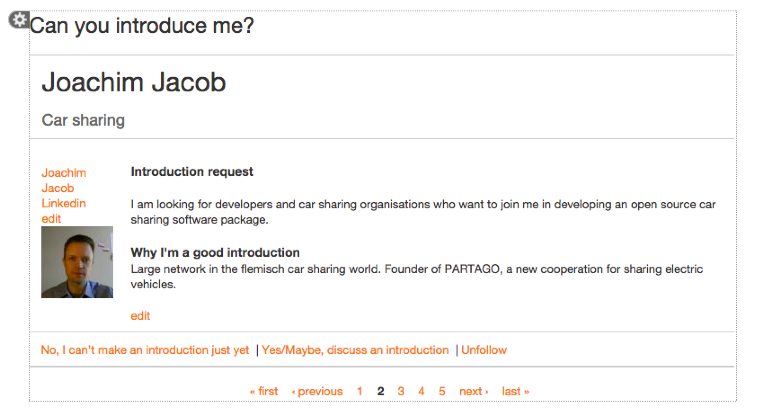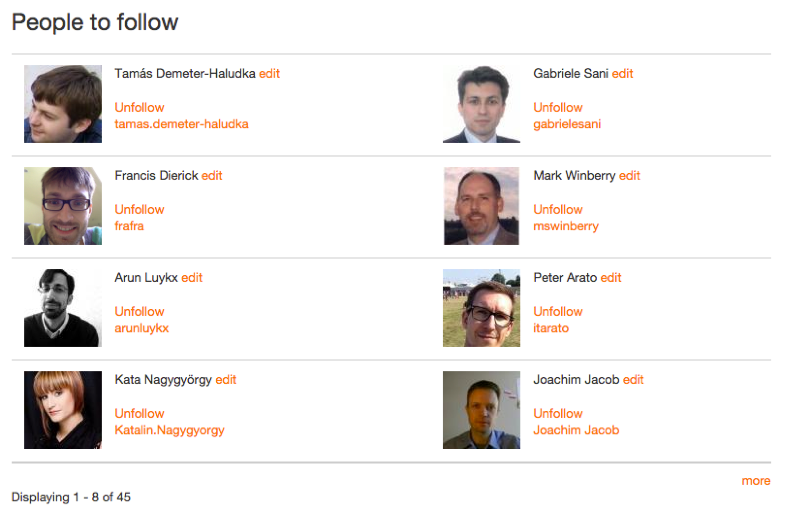Prototyping LinkForward with Drupal, a startup case study
Breadcrumb
- Home
- PronovixBlog
- Prototyping LinkForward with Drupal, a startup case study
This is the story of how I built a first prototype for LinkForward, a web application for power networkers, and how I built it in record time using Drupal (12 hours), without a single line of custom code.
Today, MVP (Minimum Viable Product) is a part of every startup founder’s vocabulary. But almost 10 years after Steve Blank first published his ideas on customer development in “The Four Steps to the Epiphany”, I’ve seen myself and countless other startup enthusiasts over-invest in the development of their first prototype for web applications. When I talk with founders about their startup they will often say they are building an MVP and then immediately go on listing a long list of complex expensive features they believe their product will not be viable without (instant messaging, video chat, you name it). The worst is, I’ve done the same several times now. In the beginning of the year, when I got the idea for LinkForward, I decided to do things differently.
LinkForward is a web application that makes it easier to build and maintain a high quality professional network. Its goal is to make it easy for 2nd degree connections - that don’t know each other but that have someone in common - to introduce each other to their own network. I started building it as a side project because I felt that there is a serious need for a tool that makes it easier to be a power networker. Since mid 2014 I have been working much more consciously on my network. Even though I had returned to Belgium 5 years ago, I realized that I wasn’t really connected into the IT scene at home. Along the way I started feeling that there is an important gap in my networking toolset.
I’ve now got over 2k connections, and many of them I no longer remember. I would love to have a tool that helps me make stronger, more meaningful connections. That helps me build a vibrant, active network with those people that will help me make a bigger impact on the world. Just before New Year, I had joined a friend and her co-founder to advise them about their startup. To implement their idea they wanted to build an AI that would be able to make recommendations to people. In that discussion I suggested them to think of using a network of people as an alternative for expensive and complex AI, this is how I got the idea for LinkForward.
I really love Linkedin, I was never really good at organising business cards, and Linkedin gave me a much better alternative to keep track of my professional network. While Linkedin is great for retaining business connections, it’s inadequate if you want to actively foster your relationships. I see 3 big problems:
A little while back I read Pretotype it a free book by Alberto Savoia. While his ideas are very similar to the Minimal Viable Product that Steve Blank popularised, this book helped me to finally get it. You see, when Steve Blank introduced MVP he left it really open what viable meant exactly. And there are a lot of interpretations that range from:
The problem is that most startup founders go from demand validation (e.g. talking with potential customers, landing pages, mockups or crowdfunding campaigns) straight to their Minimum Loveable Product. In the process a lot of founders invest loads of time and money in demand that was only validated as an idea. And this is where a lot of people fail badly: they get initial traction and start investing in an idea that people think is great, but there is a really big difference between something that sounds great and something that will actually work.
That is why I’ve learned the hard way that you should build a pretotype before you build your version one. And your pretotype should be modelling the engine of your startup, the key interaction that you believe will be bringing value to your customers.
If the engine doesn’t work you can add all the whistles and bells you want, they will not make your startup a success. On the other hand if you can get that basic interaction going, even if it’s only for a small group of people, and not very effectively, you can start experimenting how you can get from there to a product that people will not just like but actually love.
So how do you build your startup’s engine? For LinkForward the initial idea was that introduction requests would be the engine of the community platform: When a user signs up, they can ask an introduction request from the community. When another user in the network knows someone who would be a good introduction, they can flag that person and receive an email they can forward to the person in question.
I built the first iteration for LinkForward on two consecutive evenings, in about 8 hours of work. To do so I used Drupal Gardens, a hosted Drupal solution built by Acquia. With it, it’s really easy to get a Drupal site started without any developer or system administrator knowledge.

It had been a while since I last built a Drupal site, and my Drush knowledge had become a bit rusty (read I forgot everything). I could have asked my colleagues to set up a site for me, or have brushed up my command line knowledge, but I wanted to show that it is possible to make a prototype in Drupal without any real coding skills. The only thing I asked help with was the setup of the nameserver so that I could have a real domain and not just a subdomain.
Setting up the introduction request was really easy: I just added the fields for it to the user profile. The most of my time I spent on tweaking the View that was going to display one user’s ask at a time and the 2 flags I created to let a user interact with the system. Since I didn’t want to involve a themer, I had to do some trial and error positioning the fields using an HTML table (ok maybe this is a bit more hardcore Drupal skill, but I personally don’t consider HTML to be code, since you are manipulating the output directly).
After these 2 evenings I spent another 4 hours doing some extra polishing. I’m not sure anymore when I wrote the content for the home page and the about page, but after approximately 12 hours of work, I went onto Skype and pinged about 70 friends, mostly from the Drupal community, who I thought the product might be relevant for. That is how I got the first 7 users.
Several friends suggested me to check out BNI (Business Network International), “the world’s largest referral organization” founded in 1985 by Dr. Ivan Misner. I found a chapter in Ghent that was having their weekly meetup on Wednesday at 7am, I called them up and was able to attend the next morning. From the approximately 30 people that morning 12 signed up for an account.

The 3rd group I recruited from was the attendees at BootCircle, the monthly meetup I organize for startup founders in Ghent and Leuven. I also handed out flyers (black&white hand torn copy machine quality) at a few other meetup events I attended, that got me another 12 participants. Including a few colleagues that brought the total to about 40 participants. Meetup.com, a site that facilitates the organisation of local “user group” style events is a really powerful tool for setting up ad hoc meetings where you can get feedback quickly from people in your target audience.
With this initial group of people, I could already see that the engine was not yet working: most of the people that signed up didn’t return, even after they had been prompted. The engagement rate was also rather low. That is why I took the site off of Drupal Gardens so that I could do a few experiments with gamification modules.
I used the user points module in Drupal to create introduction points: every time you flagged that you wanted to introduce somebody, a point was awarded to you and subtracted from the person you indicated you could make an introduction for, a typical gamification scheme. Initially I used flag actions for this from the flag module. But I bumped into some of the limitations of the flag module, and in the end I decided to power up.
This is why I installed the rules module. Rules is Drupal’s blackbelt toolbox, it allows you to model complex business logic without a single line of code. Sending emails, adding or removing points, but also publishing and unpublishing nodes, there are few things you can’t do out of the box with Rules.
I wanted to encourage my users to invite their friends to the platform. Setting this up is trivial with the invite module if you are fine with a simple email invitation system. It’s also possible to extend the module with other types of invitations, but those don’t come out of the box. The invite module works together nicely with the user point module, so that you can award points when a member invites a new user to the platform.
At some point I thought I might be able to improve engagement if I would offer offline introduction groups a virtual place to facilitate the introductions they made. That is why I installed the organic groups module that allows you to set up sections of your site where users get different permissions depending on their group membership.
To make it easier to create a new account and to login, I added Hybridauth a module that lets you integrate with a host of social login services. With it, you can create a new account on the site with a single click of a button, copying your information from the social network service.
Francis, a founder friend who I am masterminding with about LinkForward, suggested that we might increase engagement if a customer could add more than one introduction request. I moved the request fields into their own content type and refactored the views and flagging system to enable it.
All of these changes happened on the live site in configuration only. So not in a code driven way, using features, the way we normally build sites for our customers. I would strongly recommend against this kind of live fine tuning for established business platforms where customers have a fitness and continuity expectation. For a startup however, this kind of agility and live tweaking makes Drupal an extremely powerful platform that allows you to learn at minimal cost in really short time frames. With proper warning, I believe this could even be used in an enterprise environment for a beta pilot.
Linkforward is not yet working the way I want it to - its engine is still sputtering - but through the experiments I’ve done in the past months I’ve learned a lot of valuable lessons. Crucially those lessons were really affordable: I estimate I’ve spent about 80-100 hours of my own time, my assistant has spent about 10 hours sending emails as part of one of the experiments, I had about 10 hours of technical support from our developers to set up the site and to install the modules.
Next for Linkforward I’ve got a big overhaul in mind and I’m still considering if I want to throw away the current site, copy over the content and rebuild, or if I want to continue working with the existing site base. There is a minor image upload bug that I don’t want to waste developer time on, so I might as well just restart for the new prototype. I can copy over a lot of the configuration work, so that wouldn’t be such a big deal.
I’m really excited about this project for another reason: It demonstrated that it is possible to provide a lot of value for very little developer time. That is why with Pronovix we’ve decided to launch a service based on this principle: dripdojo.com. It is a service specifically designed for intrapreneurs or entrepreneurs who would like to take a hands on role in the design of their innovation project. The goal is to help them validate the engine of their idea before larger investments are made.
We’ve also been actively using our experiences when advising our startup customers, nobody can afford investing in features that people won’t use, especially not when you are trying to launch your startup…

Kristof Van Tomme is an open source strategist and architect. He is the CEO and co-founder of Pronovix. He’s got a degree in bioengineering and is a regular speaker at conferences in the API, developer relations, and technical writing communities. He is the host of the Developer Success & the Business of APIs and the API Resilience podcasts.
Articles on devportals, DX and API docs, event recaps, webinars, and more. Sign up to be up to date with the latest trends and best practices.

